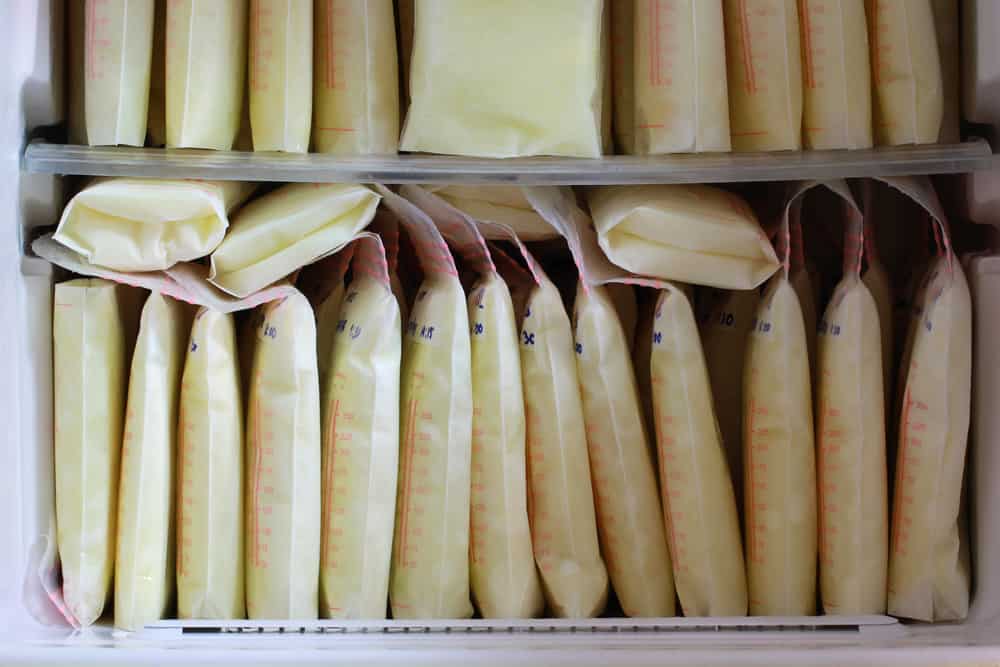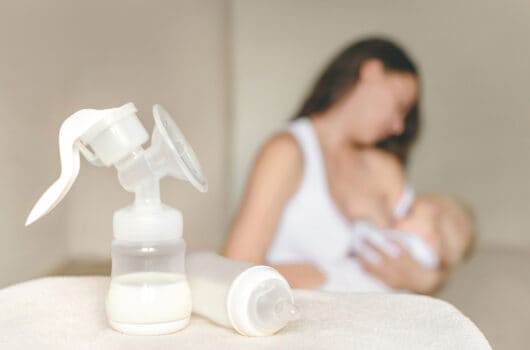For many moms, breastfeeding and pumping go hand-in-hand when it comes to feeding their babies. Sometimes they may pump, and the rest of the time, they may breastfeed. But what about only breastfeeding or only pumping? What are the pros and cons of each feeding style?
Choosing one over the other may come down to personal preference, lifestyle (like having to go back to work), or even health considerations. Sometimes you may even have to change the way you feed based on your baby’s needs. Your baby may struggle to breastfeed, for example, or you may need to teach them to take a bottle for daycare.
Whether you plan to breastfeed or pump exclusively, or you want to do a mix of the two, we’ll cover the advantages and disadvantages of both feeding styles so you can make the best choice for you and your baby.
Breastfeeding Pros & Cons
Breastfeeding is the natural way to feed your baby, and because your body was designed to give your baby milk, there are many advantages to breastfeeding. You may think pumping has the same benefits since the result is the same: your baby drinks your milk. However, when you compare breastfeeding and pumping, there are distinct advantages and disadvantages.
Pros
To help make your decision, let’s take a detailed look at the benefits of breastfeeding.
Baby Bonding
The closeness you feel to your baby when they’re cuddled up against you is a big part of breastfeeding. It helps that as your baby gets full and content on your milk, your body releases the feel-good chemical oxytocin. This chemical makes you feel relaxed, happy, and loving toward your baby.
Convenient
You can’t beat the convenience of breastfeeding. You don’t need bottles, sterilizers, or storage containers. You don’t have to warm the milk or worry about bringing along enough food for your baby when you leave the house. And best of all, you don’t have to go through an elaborate cleaning and sterilizing process. Although we do recommend regular showers—you know, when the baby actually lets you have time to yourself.
Health Advantages for Baby
Your baby will receive your milk with all its amazing health benefits whether you breastfeed or pump, but breastfeeding is better for your baby’s jaw development. This is because it’s harder for your baby to suck on the breast rather than a bottle’s nipple, so it helps form strong jaw muscles.
Milk Tailored to Baby
This sounds a bit like magic, but when your baby breastfeeds, a little bit of their saliva gets into your nipple—like backwash—and then your body makes milk that is exactly what your baby needs. So, if your baby gets exposed to a cold, then your breasts make antibodies to help them fight it. Amazing!
Free
Or as close to free as you’re going to get. You may need to buy some nursing bras and lanolin for sore nipples, but you don’t have to purchase pumping accessories, bottles, milk storage bags, bottle warmers, and bottle-cleaning supplies.
Cons
While breastfeeding has many benefits, there are some drawbacks to it as well.
One Woman Feeding Machine
If you’re breastfeeding your baby, then all the responsibility of keeping your baby full and happy falls on you. There’s no relief—even at night. And if you’re a new mom just getting used to nursing, then you might not feel comfortable leaving the house yet at all! Your partner may help with some of the feedings, but you do the majority of the job. It’s a lot of work!
Poor Latch
Sometimes, babies are born with problems like a tongue-tie, palate deformities, or cardiac defects that cause them to struggle with breastfeeding. Other times, babies don’t ever really get the hang of nursing. When they can’t latch onto the nipple correctly, this causes pain and discomfort for you, and poor nutrition and weight loss for them.
Uncomfortable
Hopefully, you’ll never get a blocked milk duct or mastitis. However, even with the most accomplished breastfed baby, you’ll still experience overfull breasts at some point. This is because babies often suddenly start sleeping through the night (hurray!), or they wake up one day and decide they’re not that hungry today, thanks anyway. Some discomfort with breastfeeding is just par for the course, unfortunately.
Feeding in Public
Breastfeeding in public is a natural thing that is protected in most places by law, but that doesn’t mean moms feel comfortable doing it. Sometimes babies don’t cooperate; they struggle to latch or fight the blanket you attempt to use for modesty, and then it feels like you’re exposing your breasts to the world.
Pumping Pros & Cons
Pumping makes it possible to return to work and continue breastfeeding, and it’s the ideal way to combine breastfeeding and bottle-feeding. Your baby gets the benefit of drinking your breast milk, with the added flexibility of the bottle. Despite providing your baby with your breast milk, pumping isn’t the same as breastfeeding. It has its own advantages and disadvantages, which we’ll detail below.
Pros
Pumping has several unique benefits that may make it more appealing than breastfeeding for some new parents.
Back to Work
If you need to return to work after having your baby, but you still want them to have the benefits of your breast milk, then pumping is the best way to do that. Your baby’s daycare or caretaker can give your baby the same milk they would get if you were breastfeeding.
No Formula Needed
Formula is expensive, and sometimes babies don’t tolerate it well, especially if they have a cow’s milk allergy. Pumping allows you to use your own milk, which is generally easier on your baby’s tummy. And your wallet.
Help From Family
While breastfeeding is a one-woman job, pumping allows you to pour that milk in a bottle. And then when Grandma, Grandpa, or the neighbor down the street wants to hold the baby, you hand them the bottle, and instantly, you have help feeding the baby! This is especially helpful at night when you can hand off some of the night feedings to your partner instead.
Family Bonding Time
Bottle-feeding allows other family members to bond with your baby. When you only breastfeed, everyone else in your family rarely gets the opportunity to hold your baby, much less feed them. There’s just something so sweet about cuddling an infant close and giving them a bottle so that everyone can join in on that chance to bond.
Measurable Milk Consumption
You might have noticed this already, but your breasts aren’t translucent. They don’t have handy measurements on the sides so that you know exactly how much milk your baby is drinking, but bottles do! If you have a baby struggling to gain weight, it’s especially important to know how much milk they’re getting.
Cons
To get the full picture, let’s dive into the cons of pumping your breastmilk.
Special Supplies Required
Health insurance companies are now required to cover the cost of breast pumps. You save on that expense, but you’ll need other supplies to feed your baby your pumped milk. You’ll need milk storage bags, bottles, sterilizing and bottle cleaning equipment, and possibly a bag to store it all in. All of that adds up, and it’s more than the cost of breastfeeding.
Not Fun
Breastfeeding involves sweet cuddle time with your baby. Pumping involves attaching plastic cups on your breasts and removing the milk with electronic suction that’s anything but sweet and relaxing. Sometimes, it’s even uncomfortable.
Lots of Cleaning
Breast pump parts have to be cleaned each time you use them and sanitized at least once a day. You’ll also spend a lot of time cleaning and sanitizing bottles and nipples, which isn’t the most fun activity, especially when you’ve just had a baby.
Inconvenient
Breastfeeding in public can be uncomfortable, but your baby covers most of you. It’s a lot harder to pump in public, especially if you have an electric one that needs an outlet. Finding a private space at work to pump can be difficult, too, and too many moms are forced to pump in the bathroom.
Inefficient
A pump can never remove as much milk as your baby can, and this can lead to problems with your supply. It can also be frustrating for you because you might spend hours pumping with little milk to show for it.
What Is Exclusive Breastfeeding?

Exclusive breastfeeding means you give your baby breastmilk only, with no formula or baby food. The World Health Organization (WHO) recommends exclusively breastfeeding your baby for at least six months and then continuing to breastfeed and give solid foods until two years old or older. How you choose to give your baby the breastmilk is up to you, though. It can include a mix of nursing at your breast and bottle-feeding pumped milk.
Why Choose to Exclusively Breastfeed?
Breastfeeding has lots of practical advantages, such as convenience, low cost, and not requiring any additional supplies. But the main advantages of breastfeeding are how it benefits your baby’s health and yours.
Breastfeeding Reduces Your Baby’s Risk Of:
- Obesity
- Asthma
- Respiratory disease
- Diabetes
- Sudden Infant Death Syndrome (SIDS)
- Ear infections
- Gastrointestinal infections
Breastfeeding Reduces Your Risk Of:
- High blood pressure
- Diabetes
- Breast cancer
- Ovarian cancer
And of course, breastfeeding is ideal for baby bonding, comforting (as long as you don’t mind becoming a human pacifier), and losing the weight you gained during pregnancy.
What Is Exclusive Pumping?
In contrast to exclusive breastfeeding, which can include pumping, when a mom says she’s exclusively pumping, that means she’s only using a breast pump to remove the milk. The milk doesn’t have to be removed from an electric pump, though. You can also use a manual pump or even hand-expression.
Exclusive pumping can also include supplementing with formula. The “exclusive” part means the pump is the only way breast milk is removed—there’s no nursing at the breast involved.
Why Choose to Exclusively Pump?
There are many reasons moms might decide to exclusively pump, and they primarily have to do with their baby’s needs. Nursing at the breast is hard work, and sometimes, babies have problems with being able to latch on properly.
Special Needs
Babies born with physical problems, such as cleft palate, cleft lip, congenital heart disease, or a congenital heart defect, struggle to breastfeed. Babies born with Down syndrome may also have physical problems, like low muscle tone, making it difficult for them to nurse.
Baby Refuses to Nurse
Sometimes, no matter what you try, your baby just can’t latch on properly. Struggling to breastfeed causes frustration for the baby and you, and it can also cause you to have physical problems, like cracked and bleeding nipples.
Baby in the NICU
If your baby is born premature or has some other medical issues after birth that requires a stay in the NICU, they may be unable to breastfeed. You may miss that window at the very beginning to teach your newborn how to latch on, and then it might be too difficult to breastfeed after your baby leaves the NICU.
Weight Gain Issues
If your baby is struggling to gain weight, the pediatrician might recommend supplementing with formula or pumping so that you can measure exactly how much milk your baby is drinking.
Personal Choice
Some moms just don’t like the idea of nursing at the breast, or it doesn’t fit in with their lifestyle. They may want their family members to help feed the baby a bottle; they may work or find that breastfeeding has always been a struggle. Whatever the reason, it’s the mother’s choice.
How Much Do You Need to Pump?
So here’s the bad news on exclusively pumping: you pretty much have to pump around the clock, especially in the beginning. And unlike nursing, you pump to remove the milk, and then you have to feed your baby separately. It doesn’t all happen at once.
The minimum recommended time for exclusive pumping is 120 minutes a day. If you have a newborn, you’ll need to follow more of a newborn schedule—about every two hours or so during the day and every four hours or so at night. This is to keep up your supply of milk.
Is Pumping As Good As Breastfeeding?
There are many advantages to pumping, without a doubt. The most significant advantage is that it allows you to feed your baby your breast milk, which is ideal for your baby’s nutrition. When compared to formula, all the evidence suggests that breastmilk is best. So, if you are unable to breastfeed your baby, then pumping is the next best thing.
However, pumped milk does have some disadvantages. As a baby drinks at your breast, it causes your breastmilk composition to change. Not only does it have different antibodies depending on your baby’s needs, but it also changes in fat composition throughout the day. Pumped milk can’t change in composition like it does when a baby gets it straight from the breast.
Pumped milk can also easily become contaminated. Although breast milk has lots of good bacteria to strengthen your baby’s gut, harmful bacteria can enter the milk if you’re not careful. You’ll need to clean and sterilize all your breast pump parts, thoroughly wash your hands, and store the milk in clean bags or bottles.

The milk can spoil easily if it’s not stored properly. Breastmilk is good at room temperature for four hours, but after that, you need to refrigerate it. You can store it in the fridge for up to four days. If you don’t plan to use it right away, then freezing is better. The milk can last for six months if you freeze it, and possibly even a year.
Thawed breastmilk can also lose some of its vital nutrients. Microwaving destroys the nutrients and creates dangerous hot spots, but any thawing will weaken some of the properties of breastmilk. Studies have found that breastmilk kept frozen for three months or longer reduces the fat and calories in the milk. While most of us want to avoid excess fat and calories, it’s not such a good thing for babies!
Final Thoughts
Breastmilk is the most natural food you can give your baby and is the ideal way to help them grow and thrive. How your baby gets that breastmilk depends on a variety of reasons, but ultimately, it’s your choice. Pumping and breastfeeding can work together, especially if you’re a working mom. There are advantages and disadvantages to both feeding styles, but both give your baby the breastmilk they need to thrive.
